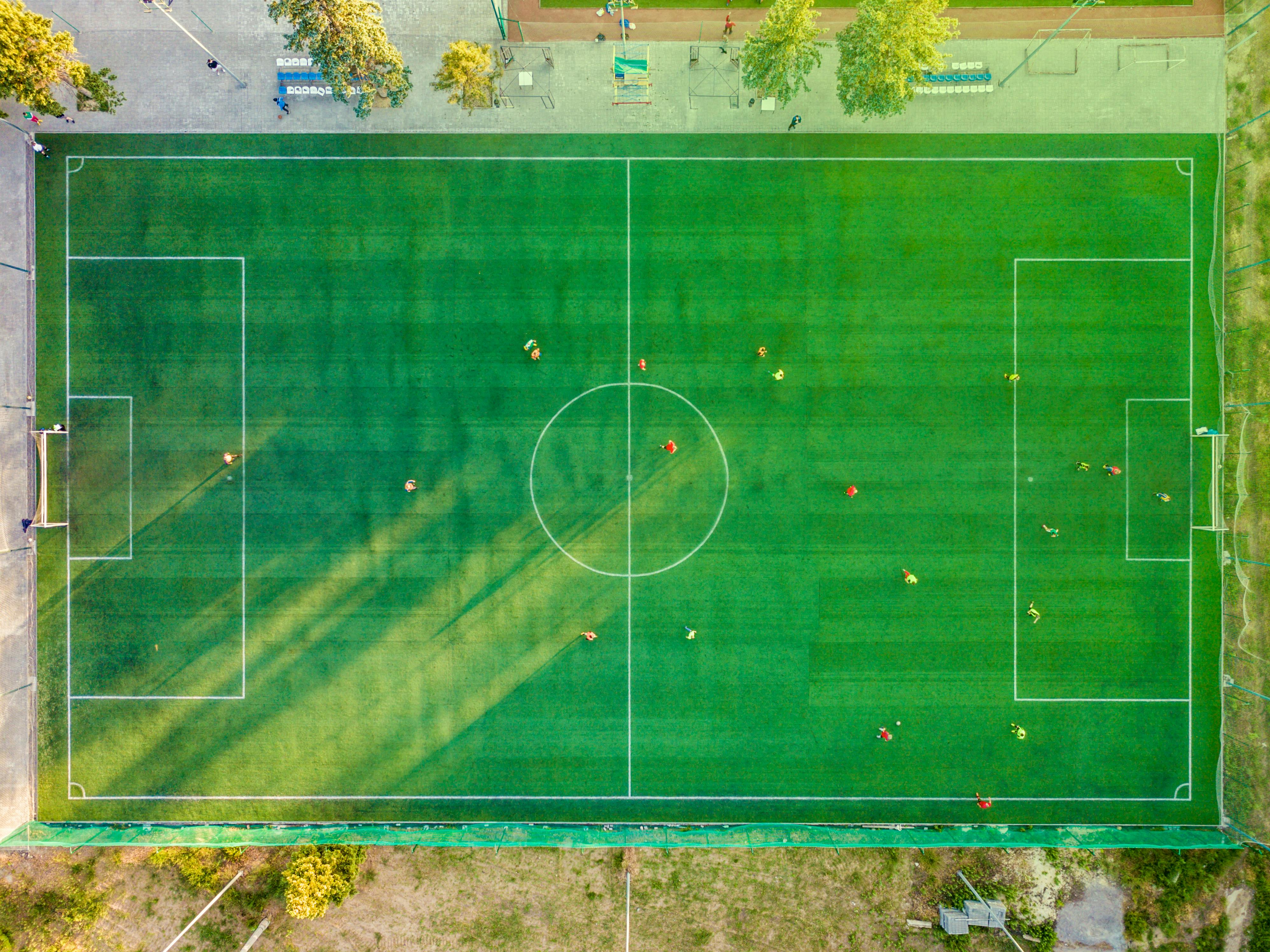Soccer is one of the most popular sports in the world, and it’s played on a large field. But just how big is a soccer field? In this article, we’ll take a look at the size of a standard soccer field, including the length, width, and other measurements. We’ll also discuss variations in size based on age group and tournament standards. By the end of this article, you will have a better understanding of just how big a soccer field is.The size of a soccer field can vary depending on the age of the players, but a standard field ranges in size from 100 yards by 60 yards to 130 yards by 100 yards. The international standard size for a soccer field is 110 yards by 70 yards.
International Soccer Field Regulations
Soccer is the most popular and widely played sport in the world, and its governing body, FIFA, has established regulations for international soccer fields. These regulations dictate the size of the field, the location of goals and markings, and other important aspects of the game. Soccer fields must adhere to these regulations in order to be approved for international play.
The standard soccer field must measure between 100 and 130 yards long by 50 to 100 yards wide. The length of each goal line must be between 8 and 16 yards, with a corresponding width of 8 feet. The penalty area must be 40 yards wide by 44 yards long, with an 18-yard penalty mark at its center. Markings on the field should include a halfway line that divides it into two halves, two center circles that are 10 yards in diameter each, and a penalty area marked by four lines extending from each goal post.
In addition to these standard regulations, FIFA also dictates specific requirements regarding field lighting, goalposts, nets, flags, corner flags, benches, and substitute seating areas. All of these elements are important for ensuring player safety as well as making sure that games are played fairly. They also help ensure that all teams have an equal playing experience when they compete in international tournaments.
Finally, FIFA requires all fields used for international tournaments to have adequate drainage systems in place. This is necessary to ensure that games can be played even in wet or muddy conditions without compromising player safety or disrupting gameplay. As such, all fields must have proper drainage systems installed before they can be approved for use in international tournaments.
Soccer Field Dimensions
A soccer field, also known as a football field, is an outdoor playing surface used for the sport of soccer. It is typically rectangular in shape and its dimensions are typically within the range of 100-130 yards long and 50-100 yards wide. The exact size of a soccer field can vary depending on the level of play and governing body. For international matches, FIFA has set specific regulations regarding field size and markings. Generally, the length of a full-size soccer field should be between 110-120 yards, while its width should be between 70-80 yards. The penalty area is 18 yards wide by 44 yards long, with the goal posts located at each end of this area. The goal posts must be 8 feet wide by 8 feet high, with a crossbar placed 8 feet from the ground. The corner arcs have a radius of 1 yard, while the center circle has a radius of 10 yards. In addition to these dimensions, there are also several markings on the field that are used in order to keep track of players and where they are allowed to move during play.
For recreational or youth leagues, the size requirements may vary slightly from those set by FIFA for international matches. Generally speaking however, most fields used for recreational or youth leagues will follow FIFA’s guidelines closely in order to ensure that all players have an equal playing experience regardless of their level or age group. As such, most recreational or youth fields will have similar dimensions as those outlined above – 110-120 yards long and 70-80 yards wide – with other markings adjusted accordingly as needed.
Soccer Field Size Varies by Age Group
Soccer is a popular sport for players of all ages, and the size of the soccer field can vary depending on the age group playing. For younger age groups, such as U6 and U8, the field size should be smaller to accommodate their skill level and physical capabilities. The recommended field size for these age groups is 30 yards by 20 yards. As players get older, such as U10 and U12, the field size should become larger in order to give them more space to move around. The recommended field size for these age groups is 40 yards by 25 yards.
For older age groups such as U14 and U16, the recommended field size is 50 yards by 35 yards. This allows players more room to move around and play a more advanced game that requires more physical capability than younger age groups. Additionally, it also gives them more space to practice advanced skills like passing and shooting without feeling crowded on the field.
Finally, for adult leagues or professional teams, the standard soccer field size is 70 yards by 40 yards. This large field allows players plenty of space to move around and practice their skills in an intense game environment that requires high levels of physical fitness.
In conclusion, soccer field sizes vary depending on the age group playing. For younger players, smaller fields are recommended in order to give them enough room to practice basic skills without feeling crowded or overwhelmed on the field. As they get older, larger fields are necessary in order for them to practice advanced skills as well as maintain a high level of physical fitness during games.
Professional Soccer Fields
Professional soccer fields are an integral part of the game of soccer. They provide a safe and comfortable playing surface for the players and a place for spectators to enjoy the game. The ideal soccer field should have a level playing surface, good drainage, excellent visibility and ample space for players to move around. Professional soccer fields are typically made up of artificial turf or natural grass, with some also featuring a combination of both. Artificial turf is often preferred due to its resilience and durability, while natural grass provides a more natural feel.
The size of professional soccer fields varies depending on the particular sport and competition being played. Generally speaking, professional soccer fields range from 100 yards (91 meters) long by 60 yards (54 meters) wide for adult leagues to 80 yards (73 meters) long by 40 yards (36 meters) wide for youth leagues. The goal area should also be included in the overall measurements when considering field size.
The layout of professional soccer fields also depends on the type of game being played and the rules that apply to that particular sport. For example, in some leagues, penalty areas may be marked out near each goal post while in other games these areas may not be necessary. Professional soccer fields usually feature two penalty areas – one within 18 yards (16 meters) from each goal post – as well as two penalty arcs located 10 yards (9 meters) away from each penalty area marking out a semi-circle shape known as the ‘D’ or ‘arc’. Other markings on the pitch include lines delineating corners and kick-off spots at each end of the field as well as lines marking out sides and halves on either side of center line running through the middle of the field.
In addition to these essential features, professional soccer fields may feature additional features such as floodlights, benches for coaches and players, goal posts with nets attached, video replay screens or even padded walls around certain parts of the field to protect players from collisions with other players or objects outside the pitch boundaries. All these features help create an exciting atmosphere at games and ensure that everyone can enjoy their experience safely without any potential risks posed by dangerous equipment or surfaces.

High School Soccer Fields
High school soccer fields are the perfect place for any student to enjoy the game of soccer. With their large fields and well-maintained grass, they are ideal for playing a game of soccer with friends or teammates. These fields usually have goals, benches, and other amenities that make them a great place to play. The grass is usually kept in good condition and is often mowed regularly to maintain its appearance. The goals are often made of metal and can be adjustable depending on the size of the field and the number of players. Benches are also available in many high school soccer fields, allowing players to rest during a game or take a break from their practice session.
In addition to playing on high school soccer fields, many teams use them for practice sessions as well. This allows teams to work on specific skills or strategies without having to travel far away from home. With the proper equipment, teams can also create drills or scrimmage games that help build team chemistry and camaraderie between players.
Overall, high school soccer fields provide an excellent area for students to play and practice their skills at soccer. With their well-maintained grass surfaces and quality goals, they provide an ideal atmosphere for anyone who wants to play the game. Whether one is looking for a place to practice with their team or just have some fun with friends, these fields offer something for everyone.
Youth and Recreational Soccer Fields
Soccer fields are among the most popular recreational spaces for children and youth. They provide a great opportunity for outdoor play, exercise, and team building. Soccer is a fast-paced, exciting sport that can be enjoyed by people of all ages and skill levels. Soccer fields come in many different sizes and styles, so there is sure to be one that fits your needs.
The size of the soccer field will depend on the number of players you plan to have playing at one time. A regulation size soccer field is typically 110 yards long by 60 yards wide, with 18-yard wide goal boxes on each end. However, if you only have a few players, or if you are looking for a more recreational atmosphere, you can opt for a smaller field. This could range from 50 yards by 30 yards to 80 yards by 40 yards.
In addition to size considerations, you will need to decide on the type of surface you want your soccer field to have. Turf is typically one of the most popular options as it provides a consistent playing surface and is easy to maintain over time. Artificial turf also offers a great playing experience and is often used in professional stadiums around the world. Other options include concrete or asphalt surfaces which may require more maintenance but can offer an additional level of stability when playing on them.
No matter what type of soccer field you choose, safety should always be your first priority when selecting a location for your soccer field or practice area. Make sure there are no sharp objects or hazardous materials nearby that could cause injury while playing. Additionally, make sure your players are always wearing proper gear such as shin guards and cleats before they start playing in order to protect them from any potential injuries as well.
Youth and recreational soccer fields provide an excellent opportunity for kids and adults alike to stay active while having fun with friends or family members outdoors. With careful planning and consideration for size, surface type, safety measures, and all regulations related to playgrounds or sports fields in your area; you can create an enjoyable environment for all who participate in the sport!
Indoor Versus Outdoor Soccer Fields
When it comes to playing soccer, there are two options for where the game can be played: indoor or outdoor. Each have their own advantages and disadvantages, so it is important to understand the differences between the two before deciding which type of field is best suited for your needs.
Indoor soccer fields are typically smaller than outdoor fields, but that does not mean they are less enjoyable. The confined space of an indoor field provides a more intense and faster-paced game, as well as more opportunities for close ball control and quick decision making. In addition, indoor fields often include boards that can be used to keep the ball in play, providing an extra level of challenge that can help players hone their skills.
On the other hand, outdoor soccer fields provide a much larger playing area which allows for more open play and longer passes. This makes the game slower-paced and gives players more time to think about their next move. The fresh air and natural scenery also make outdoor soccer fields a great place to just enjoy a casual game with friends or family.
When deciding between indoor and outdoor soccer fields, consider your own skill level and what type of game you would like to play. If you’re looking for an intense, fast-paced match with lots of close ball control then an indoor field may be better suited for you. If you’d prefer a slower-paced match with longer passes then an outdoor field may be better suited for your needs. No matter which type of field you choose, both offer great opportunities to have fun and hone your skills!

Conclusion
A soccer field is a large area of land used for playing the sport of soccer. It can vary in size, from a small recreational pitch to a full-size professional stadium. The dimensions of a soccer field are regulated and must adhere to certain rules. The length and width of the field must be between 100 and 130 yards, with the penalty area extending 18 yards from each goal line. The field should also have two goal posts situated 8 yards apart at either end of the pitch, with the penalty spot being 12 yards away from each goal post. Soccer fields can be tailored to specific requirements, such as adding additional elements such as floodlights or stands for spectators, in order to create an ideal playing environment for teams and fans alike.
The size of a soccer field can be quite versatile, making it suitable for any level of play. Whether it’s a recreational game between friends or an elite match on a professional stadium, the regulations state that all soccer fields must adhere to certain dimensions in order to provide an even playing surface for players and coaches alike. With its versatility and capacity for customization, it’s no wonder that soccer has become one of the most beloved sports in the world today!

